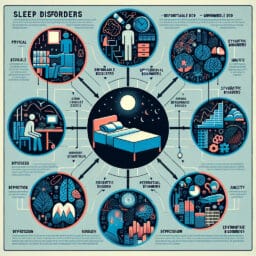
Understanding the Definition and Usage of Sedatives
Table of Contents
- Introduction
- Understanding Sedatives
- Usage of Sedatives
- Risks and Side Effects of Sedatives
- Conclusion
- Frequently Asked Questions
Introduction
Sedatives, often termed ‘tranquilizers’, are a class of drugs designed to reduce anxiety, ease stress, and promote sleep. They achieve this by slowing down brain activity, resulting in a calming effect. Among the different types of sedatives are benzodiazepines and barbiturates which work on the central nervous system to induce relaxation or sleep. While these medications serve crucial medical uses such as treating anxiety disorders or providing general anesthesia for minor surgeries, they must be handled with great caution due to their addiction potential. Improving sleep and reducing anxiety may seem beneficial but misuse can lead to serious consequences; higher doses can result in adverse side effects including impaired cognition or even life-threatening scenarios when mixed with other substances like alcohol. Consequently, prescription sedatives should never be shared among individuals and always taken under professional guidance to avoid risks associated with drug abuse or physical dependence that could lead to challenging sedative withdrawal symptoms.
Understanding Sedatives
A surprising statistic reveals that millions of people worldwide rely on prescription sedatives to relieve anxiety and improve sleep. So, how do these medications work? At their core, sedatives primarily function by impacting the central nervous system (CNS). They increase the activity of a neurotransmitter called gamma-aminobutyric acid (GABA), which slows down brain activity to induce a sense of calm or drowsiness. This is why they are often used as sleep medications or for general anesthesia during minor surgeries.
Moreover, there are various types of sedatives with differing mechanisms and effects. Two noteworthy groups include benzodiazepines and barbiturates. Benzodiazepines – commonly prescribed for treating anxiety disorders – work by enhancing GABA’s effect in the brain, facilitating relaxation and reducing anxiety symptoms. On the other hand, barbiturates are used less frequently due to their higher risks but can still be found in some settings like induction of anesthesia.
While these drugs have legitimate medical uses, misuse sedatives can lead to severe consequences. Potential risks range from common side effects such as feeling drowsy or experiencing impaired cognition to more serious issues like becoming physically dependent on these drugs. Taking higher doses than prescribed may accelerate this process leading towards addiction potential; an alarming trend noticed among individuals engaging in drug abuse involving prescription medicines.
Therefore, understanding sedatives isn’t merely about knowing their definition; it’s grasping their intricate workings within our bodies and being aware of the potential dangers they pose when misused. This knowledge aids users in striking a balance between beneficial impacts like reduced anxiety and improved sleep against negative outcomes linked with misuse such as physical dependence and withdrawal symptoms.
| Type of Sedative | Main Function | Common Usage | Potential Risks |
|---|---|---|---|
| Sedatives in General | Impact the central nervous system (CNS) by increasing the activity of gamma-aminobutyric acid (GABA) to induce calmness or sleepiness | Sleep medications, general anesthesia during minor surgeries | Drowsiness, impaired cognition, physical dependence, addiction potential |
| Benzodiazepines | Enhance GABA’s effect in the brain to reduce anxiety symptoms | Treating anxiety disorders | Drowsiness, impaired cognition, physical dependence, addiction potential |
| Barbiturates | Slow down brain activity to induce calmness or sleepiness | Induction of anesthesia | Higher risks of misuse due to its stronger effect, physical dependence, addiction potential |
Usage of Sedatives
Despite the positive outcomes such as relieving anxiety and improving sleep, misuse of sedatives paints a starkly contrasting picture filled with potential risks. The definition of sedatives encompasses a broad range of substances – from medical prescriptions like benzodiazepines and barbiturates to common sleep medications, all working by impacting the central nervous system. While these are typically administered to treat anxiety disorders or provide general anesthesia during minor surgeries, non-medical uses raise considerable concern.
The misuse of sedatives often stems from an inaccurate understanding of how these drugs work. Users tend to underestimate their powerful impact on brain activity which when altered, can induce feelings of calmness or drowsiness. In some cases, people taking these medications may feel compelled to increase their dosage without professional consultation – resulting in higher doses than prescribed. This consequential behavior leads not just to common side effects like feeling drowsy or impaired cognition; it can also pave a swift path towards becoming physically dependent on the drug.
The addiction potential associated with prescription sedatives is notably high due to the comfortable sense of tranquility they provide – making them ripe for drug abuse if not managed responsibly. It’s essential that individuals given sedatives remain vigilant about their usage and adhere strictly to recommended dosages because even slight deviations can have profound effects over time leading toward withdrawal symptoms.
In conclusion, while prescription sedicates serve critical roles in managing health conditions and ensuring patient comfort during surgical procedures, they aren’t devoid of inherent risks. Striking a balance between its medical uses against its possible drawbacks requires an informed understanding about different types of sedative medication and robust strategies for prevention against possible misuse.
Risks and Side Effects of Sedatives
Unveiling the veil of sedatives requires a deep dive into both their medical benefits and potential risks. When it comes to understanding sedatives, it’s pivotal to comprehend how they work within our central nervous system. These prescription medications increase the activity of gamma-aminobutyric acid (GABA), which essentially slows down brain activity leading to feelings of tranquility or drowsiness. This mechanism is leveraged in different types of sedatives like benzodiazepines and barbiturates, commonly used for treating anxiety disorders or providing general anesthesia during minor surgeries.
However, while these medications play a crucial role in improving sleep quality and reducing anxiety symptoms, misuse poses significant threats. Taking higher doses than prescribed can lead individuals down an insidious path towards becoming physically dependent on these substances – opening up avenues for drug abuse. The addiction potential lurking beneath the calm facade of prescription sedatives cannot be understated.
Common side effects such as feeling drowsy or experiencing impaired cognition might seem benign at first but can amplify over time with continuous misuse. Moreover, mixing these drugs with other substances like alcohol can precipitate life-threatening scenarios – highlighting the gravity of its dangers.
To responsibly leverage the benefits provided by these sleep medications without succumbing to their perils, it’s important that users follow prescribed dosages diligently. Deviation from recommended intake not only enhances potential risks but also paves way for challenging sedative withdrawal symptoms that could severely disrupt daily functioning.
In essence, while sedative medication serves vital roles in managing health conditions and surgical procedures, navigating its usage requires informed understanding about their workings intertwined with robust strategies against possible misuse – striking a fine balance between relief and risk.
| Type of Sedatives | Medical Uses | Risks & Side Effects | Preventive Measures |
|---|---|---|---|
| Benzodiazepines | Used for treating anxiety disorders and providing general anesthesia during minor surgeries. | Potential for physical dependence and drug abuse, drowsiness, impaired cognition, life-threatening scenarios when mixed with other substances like alcohol. | Follow prescribed dosages diligently, avoid mixing with alcohol or other substances, seek professional medical advice for withdrawal symptoms. |
| Barbiturates | Used for treating anxiety disorders, seizures, and providing general anesthesia during minor surgeries. | Same as above, with potential for severe withdrawal symptoms. | Same as above, with an emphasis on seeking professional medical advice for withdrawal symptoms. |
Conclusion
Sedatives, often synonymous with tranquility and restful sleep, have a much more complex nature to them. The definition of sedatives encompasses a broad spectrum of substances that work on the central nervous system, inducing calmness and facilitating sleep. Understanding how sedatives work is crucial – they enhance the activity of gamma-aminobutyric acid (GABA) in our brains which reduces anxiety and promotes drowsiness. While this mechanism aids in treating anxiety disorders or providing general anesthesia for minor surgeries, misuse can lead down a perilous path. Straying from prescribed dosages or employing these potent substances for non-medical uses can instigate serious side effects such as impaired cognition or even potential addiction. Furthermore, abrupt cessation after prolonged usage often triggers challenging withdrawal symptoms due to physical dependence developed over time. Hence, while prescription sedatives serve invaluable roles in medical treatments and procedures, it’s paramount to remember their inherent risks and ensure responsible usage to avoid possible pitfalls such as drug abuse.



